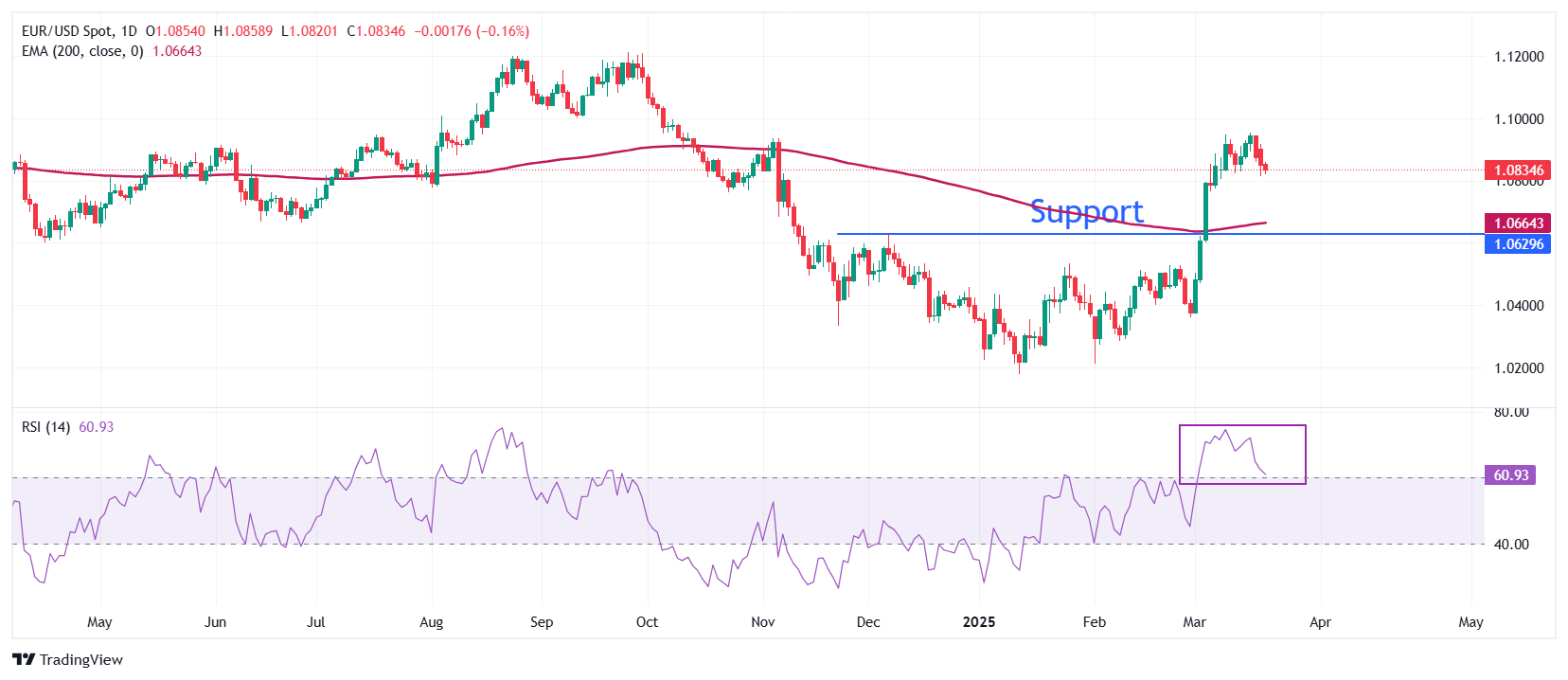- The EUR/USD falls about 1,0815 while the Fed is not in a hurry to cut the interest rates soon.
- The tariff agenda of US President Trump could lead to global cost inflation.
- The president of the ECB, Lagarde, hopes that the possible inflation led by Trump in the Eurozone is not persistent.
The EUR/USD operates down the minimum of 10 days of 1,0815 in the American session on Friday. The main currency pair faces selling pressure as the euro (EUR) falls amazing that the reciprocal tariffs of the president of the United States (USA), Trump, significantly impact the economic growth of the euro zone.
The president of the European Central Bank, Christine Lagarde, has also warned of the downward economic risks derived from the commercial war led by Trump and has mitigated the fears of persistently high inflation in the euro zone. On Thursday, Lagarde said before the European Parliament Committee that the inflationary impact of the commercial war would be temporary, since the effect “will be softened in the medium term” due to “a lower economic activity that will cushion inflationary pressures.”
The main victim of Trump’s reciprocal tariffs is expected to be Germany, a key commercial partner of the US USA. Until now, Trump has threatened to impose 25% tariffs on foreign cars and introduce reciprocal tariffs soon. Investors seek to know if the US will impose tariffs of 10% or 25% on German cars.
Meanwhile, the approval for the injection of billions of euros in the German economy through the expansion of the indebtedness limit by the officials of the Bundestag, the lower house of Parliament, support the economy in front of the fears of US tariff of the greens for the creation of an infrastructure fund value of 500 billion euros (EUR) and break the tax conservatism to increase the expenditure in defense.
Daily summary of market movements: EUR/USD falls while the Fed points out that there is no hurry for interest rate cuts
- The downward movement in the EUR/USD is also driven by the fortress of the US dollar (USD). The USD is strengthened as the Federal Reserve (FED) expressed in the policy meeting on Wednesday that interest rate cuts are not on the table on the current scenario. The dollar index (DXY), which tracks the value of the dollar against six main currencies, rises to about 104.15.
- On Wednesday, the Fed maintained stable interest rates in the range of 4.25% -4.50% per second time, as expected. The president of the FED, Jerome Powell, said at the press conference that the Central Bank will not be “hurried” to move on “interest rate cuts.” His comments that support a restrictive monetary policy position arose from the “unusual elevation” of uncertainty about the economic perspectives of the United States (USA).
- Powell commented that the implementation of new policies by US President Donald Trump could lead to an economic slowdown and a resurgence of inflationary pressures in the short term.
- During the negotiation hours in North America on Friday, the president of the Fed of Chicago, Austan Goolsbee, also supported a “wait and see” approach to the policy of interest rates in an interview with CNBC. “The Fed needs to be a firm hand and have a long -term vision on the economy,” Goolsbee said. He added that before judging how “monetary policy reacts to tariffs”, the Fed needs to know how long the “tariffs, possible reprisals, and their impact on consumers” last. Goolsbee also added that the Fed also has to interpret the impact of incoming tax cuts and other issues.
- Meanwhile, investors seek significant updates on Trump’s plan to impose reciprocal tariffs on April 2. Market participants expect tariffs to affect economic growth and increase price pressures worldwide. At the global level, manufacturers will be forced to underutilize their production capacity, which could result in a new escalation of costs by costs.
- In the Economic Front, investors will focus on the preliminary data of the purchasing managers index (PMI) of the US S&P global for March, which will be published on Monday.
Technical analysis: EUR/USD extends correction about 1,0800
The EUR/USD descends to about 1,0815 after failing to maintain the key level of 1,0900. However, the long -term perspective of the main currency pair remains bullish, since it remains above the 200 -day exponential (EMA) mobile average, which quotes around 1,0664.
The pair was strengthened after a decisive breakdown above the maximum of December 6, 1,0630 on March 5.
The 14 -day relative force index (RSI) cools after around 75.00, suggesting that the bullish impulse has been moderated, but the upward inclination remains intact.
Looking down, the maximum of December 6, 1,0630 will act as the main support zone for the torque. On the contrary, the psychological level of 1.1000 will be the key barrier to the euros of the euro.
Related news
-
EUR/USD could find a good support in its 200 -day mobile average – BBH
-
EUR/USD will consolidate in a range of 1.08 to 1.09 in the short term – Danske Bank
-
The US dollar moves up while the markets prepare for geopolitical and tariff uncertainty
Source: Fx Street
I am Joshua Winder, a senior-level journalist and editor at World Stock Market. I specialize in covering news related to the stock market and economic trends. With more than 8 years of experience in this field, I have become an expert in financial reporting.








